Avia S-199 Erla Canopy
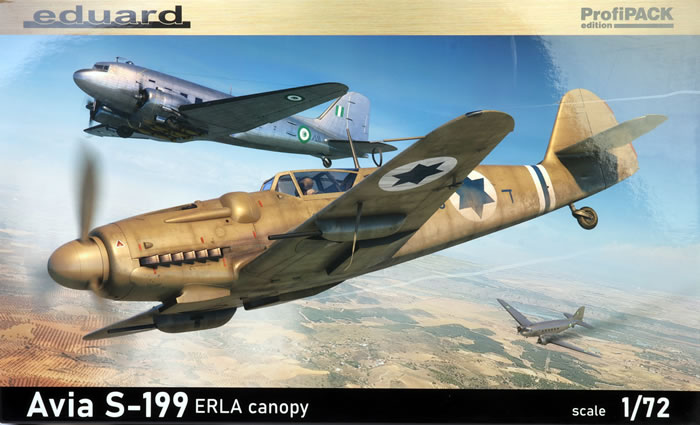
Eduard ProfiPACK, 1/72 scale
| S u m m a r y : |
Catalogue Number: |
Eduard Kit No. 70152 - Avia S-199 Erla Canopy ProfiPACK
|
Scale |
1/72 |
Contents and Media |
91 grey plastic parts: 10 parts in clear plastic: decals for six options; instructions.
|
Price |
USD$21.56 plus shipping available online from Eduard
GBP£14.50 EU Price (£12.08 Export Price) plus shipping available online from Hannants
and specialist hobby retailers worldwide |
Review Type |
First Look |
Advantages |
Well-moulded with several markings options, clear instructions, excellent decals, and a nice set of masks and PE parts to really add to the already great plastic parts.
|
Disadvantages |
None noted. |
Conclusion |
This is a splendid kit, well up to the best in the modern modelling world, and this appears to be capable of being made up into absolutely cracking little replica by almost any standard of modeller and, in the hands of an expert, will be a really wonderful project. |
Reviewed by Graham Carter

This aeroplane has been available for a while through the KP kit of 2015, which was released as the early S-99 version and in both single, S-199, and two-seat, CS-199 forms in Czech and Israeli markings. It was a highly regarded kit at the time. The later bubble-top canopy version (reviewed here a short while ago) and the two-seat CS199 has already been released, as well as a Dual Combo kit.

This kit is the early version with the Bf109H/K side opening canopy, as supplied in variants built in mid 1948. They were little different from the original 109 H/Ks apart from the changed cowl around the DB605 engine, but also had a narrow extension forward of the oval bulges over the nose machine guns, the carburettor intake moved from port to starboard sides, an oil cooler intake under the nose and the wheel geometry was altered to make the wheels more upright for easier handling on concrete surfaces. Some of the early variants had the oil intake removed and an internal heat exchanger put in the cockpit area. These aircraft were used by the Czechs and supplied to the infant Israeli Air Force as well.
The kit comes in the now standard giant strong box with a great image of one of the decal choices, Modi Alon D-106 of of 101 Sqn. dispatching a C-47 makeshift bomber of the Royal Egyptian AF over the desert in June 1948.
The parts are beautifully moulded in the familiar mid-grey and the three sprues are sealed in resealable clear sleeves with the clear sprue of canopies and sundry parts in their own sleeve for protection.
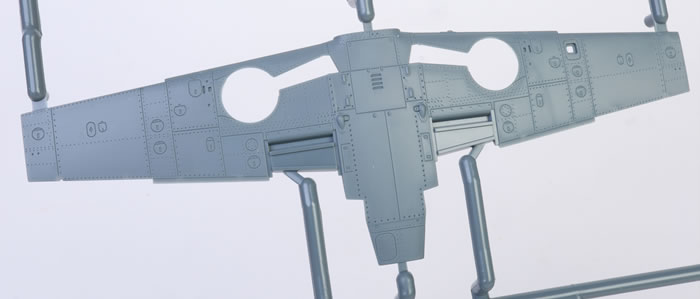
The subtle surface and interior detailing is beautifully rendered, although there has been some criticism of the rivets along the vertical fuselage panels which apparently were sanded smooth in reality - the modeller can do the same easily enough. As is usual with these kits there are a number of unused parts destined for the spares box, in this case just eight ( three of them transparencies can be saved for later projects. As a ProfiPACK Edition, you are treated to a wide selection of decal choices, six in all, a photo-etched fret and masks for wheels and canopy.
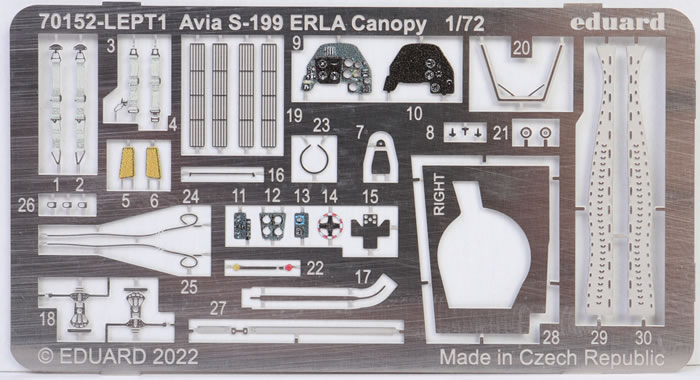
The coloured photo-etched fret contains a number of canopy details, some cockpit parts, a lovely 2-part instrument panel, seat belts, radiator matrices and some aerials. They are protected by a stout card backing.

There is an option to fit the 20mm (?) cannon under the wings. The wheels are separate to the tyres to make painting easier, although masks are provided as well.
The sixteen-page A4 stapled instruction booklet begins with an outline of the development, and usage and the reason for the name Mezek or ‘mule’ in the Czech language. There are several places where I suppose the translator has struggled with English, such as the sentence “The aircraft had high tendency to run out off the course, which had to be negotiated by the pilot’ controls input” which I suppose is meant to say “ The aircraft had a tendency to wander off course, which the pilot had to negate through his control input”. There is also a section headed “Lacking Desperately” which I took to mean that the plane Desperately Lacked Performance, which it certainly did.
Aside from those little niggles, the instructions are excellent, illustrating each step with coloured line-drawings and colour call-outs at each construction stage. Colours are indicated clearly at each step and are given in Mission Model, Gunze Aqueous and Mr. Color on a table below the parts map on page 2.
Markings
The six decal choices are illustrated with four-view drawings in colour and a nice variety there are, three Israeli and three Czech ones. As usual they are beautifully printed, glossy, thin and perfectly in register.
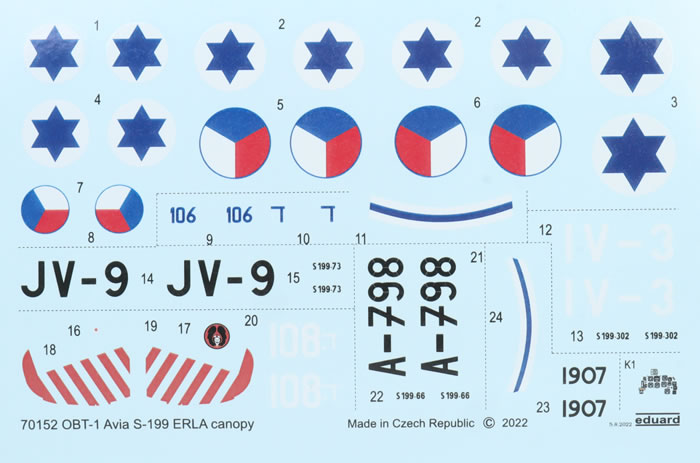
A separate sheet contains a mass of stencilling for one aircraft.
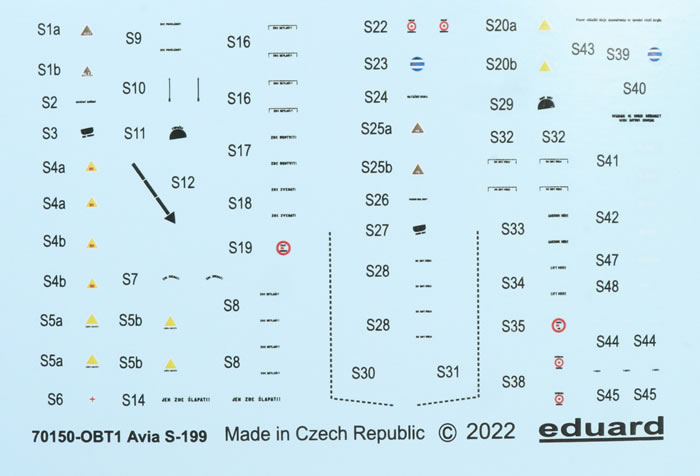
The six choices are, bar one, all in the enigmatic Czech ‘dark green’, which is simply referred to as ‘Green’ with a number in the colour table.
There is plenty of discussion concerning the precise nature of this green if the modeller wishes to dive into the ether. They are as follows (and I am sorry that I could not teach my word processor to add all the marks above the letters in these Czech names) :-
-
Modi Alon, 101 Sqn (Tayeset), Cheyl-ha-avir, Aqir, Israel, June 1948 with the nose oil intake, green spinner
-
S199.302, EZ-9 of Josef Files, Squadron 1, Fighter Air Regiment 7, Brno-Cernovice, Czechoslovakia, August 1949, with white spinner
-
S-199JV-9, Fighter Training Centre, Czechoslovakia, with red spinner
-
‘108', 101 Squadron (Tayeset), Cheyl-ha-avir, Qastina, Israel, September 1948 again with red spinner,
-
S-199.66 A-798 of Ladaslav Strnad, Air Military Academy, Hradec Kralove, Czechoslovakia, June 1950, with (theoretically at least) different coloured panels of light tan on the rear fuselage and upper cowling and a blue spinner, and
-
‘1907’ , 101 Squadron, (Tayeset), Cheyl-ha-Avir, Israel, December 1948 with a red spinner
Each aircraft is illustrated with a four-view coloured location drawing. They conclude with a stencil placement diagram, again in four views – very thorough.
It is great to see this ‘different’ variant of the later Bf 109 series available in such a beautiful kit, and it certainly comes recommended to all modellers with an interest in this aircraft type and era.
Thanks to Eduard for the sample

Review Text & Images Copyright © 2022 by Graham Carter
Images Copyright © 2022 by Brett Green
Page Created 29 September, 2022
Last updated
29 September, 2022
Back to HyperScale Main Page
Back to Reviews Page |
